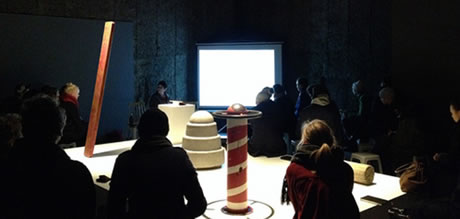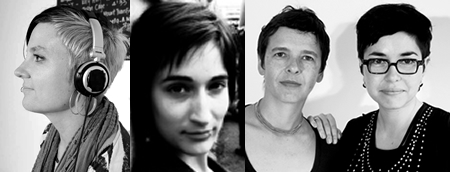| ARCHITECTURE+PHILOSOPHY 2013
Fittja OPEN talks
Experiments in site-writing
Fittja OPEN talks
Friday, 18 October 2013
Fittja OPEN, Stockholm, Sweden

Esther Anatolitis presented ARCHITECTURE+PHILOSOPHY: AN ARTISTIC FRAMEWORK. Dr Hélène Frichot and Dr Helen Runting presented QUEENS OF POMO.
Fittja OPEN as part of the Botkyrka Konsthall program is a KTH Architecture studio led by Tor Lindstrand. Botkyrka Konsthall aims to develop a model for how art can function as a catalyst for the revitalisation of a city.
Experiments
in site-writing

L-R Lauren Brown – Jana Perkovic – Hélène Frichot – Esther Anatolitis
EXPERIMENTS #3
Site-writing as performance
Esther is responding to Jana's A Manual and sending to Lauren.
Lauren is responding to Esther's art//architecture and sending to Hélène.
Hélène is responding to Lauren's Site and Sound and sending to Jana.
Jana is responding to Hélène's organism + environment and sending to Esther.
Join us at any stage. Consult your manual for texts and instructions.
EXPERIMENTS #2
12 Provocations
12 provocations by Jana Perkovic, on Hélène Frichot's organism + environment, for Esther Anatolitis.
Performed via twitter 7:00pm-8:00pm AEST Tuesday, 25 June 2013.
- Go dancing. Go out of your way to go dancing. It can be, frankly, anything. Rave, jitterbug, a concert. But you must dance.
- Bring a partner. Dance with a partner. Consider how well you understand each other.
- Bring friends. Dance with friends. Consider how you learned to dance, when you learned to dance (primary school?, high school?, university?), the role of friends, the role of friendship.
- Can you dance with a stranger? Is there a stranger opening up this possibility? Are you taking it? Can you yourself initiate a dance with a stranger? Is it erotic? Can it not be? Is it comfortable? Is it uncomfortable? What makes it so?
- Notate the gestural vocabulary of encounter with a stranger in a place full of dancing.
- Choose a 15-minute period during which you will note the full layout of the building: the spaces, the purposes of spaces. The size, the feel, the activities.
- What happens here? Where is the talking? Where is the kissing? Is there an assigned place to meet other people? Is there an area for lonely people? How many parts of the space can you enter and utilise? Who is there?
- What is appropriate attire? What is inappropriate attire? What do they communicate, the two kinds of attire?
- Are you enjoying yourself? Are other people enjoying themselves? Why?
- Remember when you were too young to go dancing, dancing like that, what you thought it would be like, how different it was from what this is now. How dancing is never about dancing only.
- Note the number of visibly displayed warnings. Note the number of people visibly employed for security purposes. Note the hard and soft boundaries.
- What is the promise of dancing? Why dance?
12 provocations by Esther Anatolitis, on Jana Perkovic’s A manual, for Lauren Brown
- Choose a place of worship from a denomination that is unfamiliar to you.
- Research when would be the best time to visit that place of worship so as not to appear disrespectful to its customs.
- Visit the place of worship with a notebook.
- List all the sounds you can identify.
- List all the scents you can identify.
- As you list, feel the stillness in the space. You have felt stillness before, but this is a different kind of stillness. Feel it in your body, in your shoulders and fingers and lower back.
- List everything you see. If there is more than one of something to see (e.g. chairs, pews, windows, candles, people), count them.
- Choose one. Quickly now.
- Draw a diagram of your position in relation to what you have chosen.
- Observe the people in the space. Dot them as a pattern onto your diagram. Within the space, where are people allowed to go? Where are people not allowed to go? Add lines to indicate the flows in the space.
- Feel your shoulders, your fingers and lower back, your eyes and your ears. Describe how the different sounds, scents and objects in the space have addressed the different parts of your body. Write in prose, a paragraph.
- What if you were to invert one of the relations or subvert one of the flows you’ve just documented? Among the objects, the scents, the sounds, the people: what is it about the space that precludes this? Having felt its stillness, would you want to imagine it otherwise?
12 provocations by Lauren Brown, on Esther Anatolitis’ art//architecture, for Hélène Frichot.
- Write down 12 things you would change about your city (if time, money and physics were no hindrance). Write down 12 things you would leave exactly as they are.
- Enter a space. Mindfully. Think about the depth of how you came to be there. Leave absent-mindedly.
- Look for a coin on the street. Think of an important design decision you need to make. Something really critical. Or expensive. Flip the coin and make a decision based on the result.
- Make a full-page inventory of high noon in the centre of town.
- Read the inventory out loud to another person. Make sure you tick each item off.
- Spend a day in the city, dressed as your alter-ego, or the person you most aspire to. Sing them a song.
- Find a brick, especially one on the corner of a building and ask it. Ask it a question you do not want to know the answer to, but must.
- Make a list of 12 artists, writers, musicians and poets who should become architects.
- Fix something. Take before/after photos. Leave a copy of the photo in public.
- Make another inventory of high noon in the centre of town, but as the person in #5.
- Meditate for 12 minutes.
- Put all your lists, photographs and costumes into a briefcase. Carry it through the city.
12 provocations by Hélène Frichot, on Lauren Brown's 'Site and Sound', for Jana Perkovic.
- Locate an airport, failing that, any busy transport hub will do (train, bus, boat...)
- Find a quiet, out of the way bench or seat, and sit down with your hands in your lap and eyes closed.
- Allow the sounds to slowly enter. But do not name them or attempt to distinguish them from each other.
- Now, commence writing a list of all the places that come to mind as you wait here; all manner of waiting places.
- You will need to spend at least an hour in this place to undertake this task.
- When you have listed at least 5 waiting places you have recalled, choose the one that is closest and go there.
- When you arrive in the next waiting place, find a quiet seat and sit down.
- Fold your hands in your lap, bend your neck till your chin nearly touches your chest and begin to hum very softly.
- Continue humming for some minutes. You may find your voice begins to calibrate to some external sound.
- Assuming your humming voice does begin to emulate an external sound, try to name that sound.
- Place identified sound on a graph or chart of your own design. It could be based on rhythm, volume, colour, taste.
- Give the chart to a friend to fill in. Ask them to find a waiting place-preferably a transport hub-to listen to.
EXPERIMENTS #1
Instructional guide
Four writers.
Four texts, diagrams, investigations.
Four sets of provocations from four texts.
Four spatial explorations performing four sets of provocations.
Four documentations of four spatial explorations.
Four social mediatised publications performing four mediatised spatial explorations.
 Experiments in site-writing: Experiments in site-writing:
INSTRUCTIONAL MANUAL
1. Propose framing text
2. List twelve provocations as a set of spatial exploration instructions
3. Undertake and document spatial exploration
4. Publish the documentation on social media as a single event
Working as individuals but guided by one another’s provocations, we will each undertake a sole spatial exploration and share the results, which in turn will generate new provocations.
Download the Instructional Manual and join us. It contains everything you need to make a little experiment or a bigger experiment with us:
- art-architecture by Esther Anatolitis
- Site and sound by Lauren Brown
- organism + environment by Hélène Frichot
- A manual by Jana Perkovic
- Site-writing provocations and procedures: your experimental constraints.
OVER TO YOU
Make a little experiment
Follow our published explorations on Twitter
Make an experiment
Perform one of our provocations
Make a bigger experiment
Gather as three site-writers and undertake the steps in the instructional table shaded blue. Join us in our guild for spatial exploration.
ABOUT THE WRITERS
Lauren Brown is an installation artist and writer.
Jana Perkovic is a writer, urbanist and theatrist.
Hélène Frichot and Esther Anatolitis are the curators.
EXPERIMENTS #1
Two framing devices
Architecture and philosophy each create the spaces they're articulated in. Experimentation is thus generative, constructive. It makes new forms and new meanings. A set of instructional texts will open a new space of exchange between our two disciplines as we perform architecture and philosophy from a distance - with you as collaborator. Join us.
We begin soon. You begin now. This year, Architecture+Philosophy invites you to become an active collaborator in our experiments. Look around you, look more closely and begin to observe. Be ready.
2012 was a reflective year for Architecture+Philosophy. Dr Hélène Frichot has marked the first year of her Assistant Professorship at KTH Stockholm. Esther Anatolitis joined Regional Arts Victoria as Director, recently launching the $2m project Small Town Transformations. And Collider, the 2012 textual collaboration with Ukrainian artist Oksana Chepelyk, has recently been published in the project's Kiev Biennale catalogue. Among all our involvements, publications, collaborations, juries and presentations, once again it's been a pleasure to work together across eight years among those inspiring spaces between architecture and philosophy.
In 2013 we return to our first love, as individuals as well as co-curators collaborating across a great distance: writing.
Esther Anatolitis and Dr Hélène Frichot
Architecture+Philosophy is
an independent, flexible public program, co-curated by Esther Anatolitis and Dr
Hélène Frichot since 2005.
Join
our mailing list to remain updated. It's a small text-only email
which you'll receive two or three times a month. You can find us on Facebook and you can also follow Hélène and Esther on Twitter.
PAST
PROGRAMS 2014 / 2013 / 2012 / 2011 / 2010 / 2009 / 2008 / 2007 / 2006 / 2005
JOIN
THE MAILING LIST / ABOUT THE CURATORS |
PAST
YEARS' PROGRAMS 2014 / 2013 / 2012 / 2011/ 2010 / 2009 / 2008 / 2007 / 2006 / 2005 /CURATORS
ARCHITECTURE+PHILOSOPHY creates a space of exchange between
the two disciplines. We welcome participants from any discipline
to engage with questions of contemporary urbanism, planning,
technology, space, system, design, distribution and other
issues in the productive overlap between the two disciplines.
We curate a diverse range of presentations, public, site-specifc and online projects, from research
students and established academics to architecture and planning
practitioners, policy makers, public artists and those working
in the world between theory, buildings and the city.
Architecture+Philosophy
has presented an inspiring diversity of thinkers, makers,
collaborators and speakers across 2005, 2006, 2007, 2008, 2009, 2010 and 2011. Be
sure to join
the mailing list to remain updated, or join us on Facebook
(below).
// JOIN
THE ARCHITECTURE+PHILOSOPHY MAILING LIST
// TODAY
I MAKE A PERSONAL COMMITMENT TO THE FUTURE WE DESIGN TOGETHER
// archandphil A PLACE FOR THINKING AND DOING BETWEEN ARCHITECTURE AND PHILOSOPHY |
|




